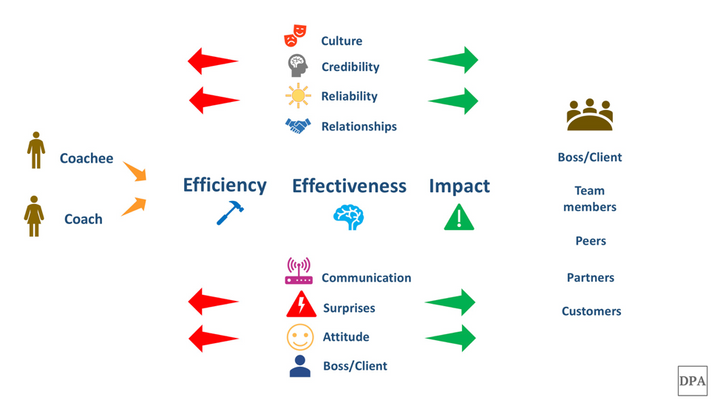Building a Personal Leadership Framework

I frame my leadership through a lens of leaving the people and places I work better than I found them. This may seem trite, but its simplicity helps me frame my decisions, actions, and contributions.
I break down my approach into two categories — people and processes.
Your version will be uniquely you. This is what it looks like for me.
People — my team members, peers, direct reports, their direct reports, other employees, customers, suppliers, clients, and bosses.
1. People have varying needs over time. A useful construct is to remember that while the names on your team don’t change every day, the people that show up do change. I developed practical psychology skills early in my career in the estate auction and restaurant business. By taking the time to connect with a person, I’m able to more quickly understand what drives them, what’s important to them and what’s not.
—Some bosses are best approached with a problem at 8 AM and others on Thursdays. I adjust my approach.
—Some people don’t read past the fourth bullet of a report, and others want a 5-page deep dive on the issue at hand. I adjust my approach.
—Some show up an hour early to get organized, in silence, for the day ahead. I respect that time by leaving them alone.
—There are people who suffer in silence with a problem. I let them know that asking for help is heroic and try to lend a hand.
2. I set personal performance standards that no boss has ever requested of me. I developed a list of preferences and requirements to guide my decisions. I know months before I leave a company that it’s time to go. I choose to work for people that I respect and don’t work for people I don’t. By working for and with people I respect, by making sure there is a worthwhile purpose, and by setting high standards, I’m able to serve others and the company at a high level and deliver value. If those things aren’t in place, somebody else is better suited for the role.
3. I have high expectations for what my team members can accomplish. I push them to grow by placing them in situations for which they don’t think they are ready, but in which I believe they will grow and excel.
4. I speak honestly and bluntly to my peers and bosses, expecting that they understand and accept that the decisions we make as senior leaders impact employees and their families.
— I take leadership personally
— I tone down my style for other audiences, but still speak plainly and give people the facts.
— I believe straight talk is respectful
— There are times when people didn’t respond to my direct style. The people who cared the most and wanted to grow and contribute thrived on my teams.
— I also found that those that couldn’t accept straight talk, were not engaged, or were simply dishonest, tended to clash with me. These folks didn’t enjoy my style of leadership. And I’m good with that.
5. When we drive the figurative company car into a performance ditch, I take responsibility and accountability for the problem. When we succeed, it’s due to individual and team effort that meshed to deliver a result. This is not a form of martyrdom; it has peoples’ backs and acknowledges collective contributions. I view mistakes as a form of tuition — learn quickly from what happened and move on with the expectation that the mistake won’t happen again. No victims. No villains. Mistakes are experiences to inform us and help us get better.
6. When leading, my motives focus on what’s best for the team and company. It’s possible that I miss the mark with my assumptions and the direction I’m leading. But it’s missing the mark doing what I believe to be right for the people and company rather than focusing on self-interest. Self-interest may show up as comfort, job security, convenience, or desire to not confront an issue.
7. I work best with smart people that care. People that have a high give-a-damn index and push others to excel, even if they do it in a prickly manner. These people challenge me to be a better leader, and I respect them for it even if it doesn’t always show up at the moment. It’s always fair to help people (and ourselves) to improve our interpersonal skills. It’s unfair to expect people to change their personality and fit an invented standard. We aren’t sheep and our diverse backgrounds, views, intellect, and values serve to create a more robust, high-performing team and company.
8. As a leader, I am fond of a few sayings and questions that I use regularly:
— Customers pay 100% of our salaries
— Give him a bigger pile of dirt to shovel
— If you kick out the side of a circle, the whole circle expands and stays that way. (Helpful in discussing our circle of influence)
— As long as I’m here, I’ll have your back.
— Information is data endowed with relevance and purpose (HT: Dr. Peter Drucker)
— What else could this mean?
— How do we know?
— What are the unintended consequences?
9. My best work came when I was fortunate to have a smart and passionate group of people come together with a common purpose. That’s the definition of a team. As a leader, there is nothing more challenging or satisfying than working toward a common, worthwhile goal with talented people.
10. I provide structured or informal training and coaching to employees, and ask other leaders to do the same, to spread the tacit and explicit knowledge across a wide range of employees. Knowledge integration is key to a scalable and sustainable business. Key to success is a culture that values knowledge sharing rather than knowledge hoarding.
11. I remember that the best thing I can do as a leader is listen, learn, and remove obstacles that are keeping people from performing at their best.
Processes: a group of activities that, taken together, create value for the customer
1. After people, the most significant point of leverage is to improve or replace the processes that exist to get work done.
2. By reviewing what’s not working well, and then creating a simple process map of activities, we can identify areas of improvement. If the survival of the company isn’t on the line, I decide what to work on by picking a process to improve in days or a few weeks. The team practices process mapping and improvement skills and refine them over the course of the first project. We then tackle the more significant process with the confidence of a small win behind the team.
3. Improving performance requires making decisions and taking action.
— A company unable to ship its biggest machine for nearly a year dispatches its first unit only a month later. How? Set the expectations, focus on a delivery date, tear down some walls, update the bill of material, quickly sell smaller systems to generate cash, and put non-essential activity on hold.
— A company had three accounting systems that held special powers and magical data residing in each. It moves to a single system in six months. How? Decide to move to one system. Set a deadline. Don’t allow anyone or anything to stand in the way of the integration. Publicly promise the business that a single version of the truth would be in place by the due date.
4. Set up measurement systems and track the levels and trends of performance over time. This answers the vital question: How do we know? Take that information and use it as an input into analysis, synthesis, and decision-making. Follow up to hold everyone accountable for results.
Exercise: Build your leadership framework
Step 1: Write down why you lead
Step 2: Write down how you lead
Step 3: Review your completed work and list or highlight three things that surprise you about your answers. Why did it surprise you?
Step 4: Which items made you feel uncomfortable as you wrote them? Highlight these. If you didn’t write something because it made you feel uncomfortable, add that to the “how you lead” list. Take some time to think about your discomfort and its causes. These are often the areas that will have significant leverage if we can take steps to improve them.
Step 5: Choose no more than three things to work on for your improvement.
Step 6: Revisit the list every few weeks to check in on your progress and to add discoveries or refine the original. Like your leadership effectiveness, the list will evolve.
Takeaway: It’s a powerful exercise in self-awareness and self-development to write down what leadership means to you and to take an inventory of your strategies, tactics, and skills. Thinking about it gets you 10% of the way there, but writing it down makes it real. Leadership is evolutionary and requires us to relentlessly challenge our assumptions, preferences, requirements, and behaviors to improve our effectiveness. Taking this personal time compounds your leadership return on investment.


